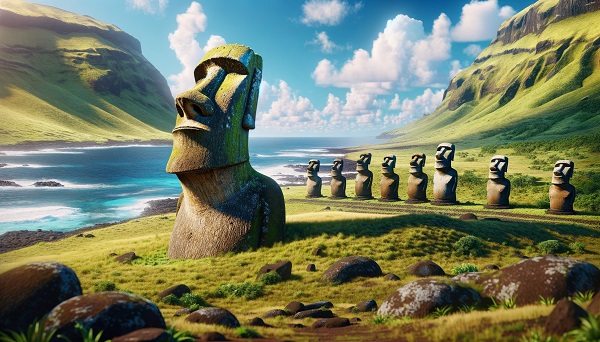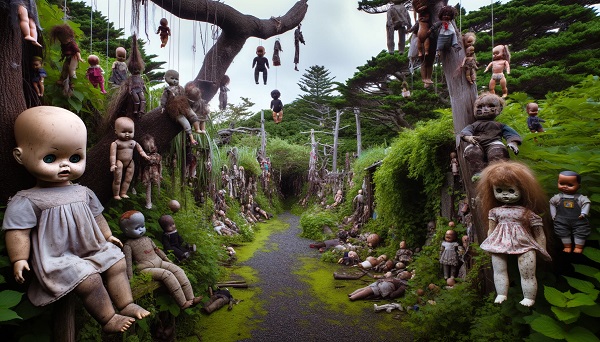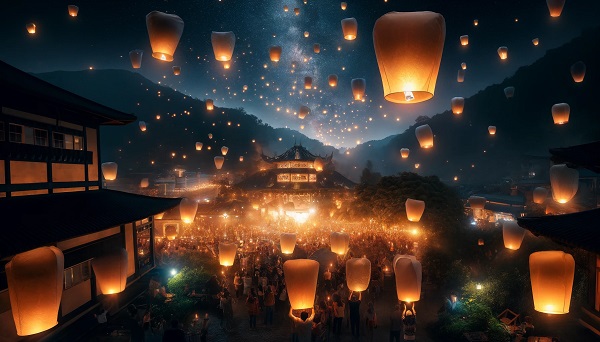
Easter Island: Unravelling the Mysteries
Kay
- 0
Hi there! Are you familiar with Easter Island? I bet you are, because this small, remote island in the sea between South America and New Zealand probably has the most mysterious history of any place in the world. The small islet in the southeastern Pacific ocean is home to the gigantic Moai statues, but there is really more to discover. Let’s find out together what the secrets are of one of the most distant inhabited islands in the world: Rapa Nui, known abroad as Easter Island.
The Mysterious Easter Island
Location and Geography
Far, far out in the Pacific Ocean, 2,300 miles west of Chile, lies Easter Island. This is as isolated as islands get in in today’s populated world. The island is triangular in shape. About 63 square miles across, it bears an astonishing variety of topographies in such a small area: volcanic craters, grassy plateaus, rocky, precipitous coastlines.
Discovery and Early History
The island was first sighted by Europeans on Easter Sunday three centuries ago in 1722. But the name ‘Easter Island’ merely refers to that particular day: the island was already well-populated before, the home of the Rapa Nui people who are believed to have reached the island sometime after 1200 AD from Polynesia. Over time, they developed many aspects of their unique and fascinating society that we now know largely through their breathtaking archaeological remains.
The Moai Statues
Origins and Purpose
But the most recognizable feature of the island are the Moai statues. These oversized human figures are carved from volcanic tuff and reach heights of between 6 and more than 30 feet. Who were the statues made for? If they were carvings of ancestors, it would be a kind of ancestor worship – a story that finds parallels in other parts of Polynesia, suggesting that they represent an important person with the task of overseeing the people and guaranteeing their wellbeing.
Construction and Transportation
What’s it like trying to move a 30-foot, 80-ton statue without a crane or jack – the way the Rapa Nui did it? Quarried in the Rano Raraku volcano, the statues were transported across the island, probably with a combination of sledges, rollers and ropes (though some think the statues ‘walked’ under their own power – upright – by rocking).
Theories Behind the Moai Statues
The Moai have stimulated countless theories, ranging from the notion that they were a monumental part of a complex cult system and political tool, to the understanding that the images were secondary to the solemnity of their platform, or a latter use with a new sacred function, to a theory that Rapa Nui was a cardinal point in the Polynesian triangle connecting themselves with other islands. It is as though the full story of the Moai will remain forever impenetrable.
The Rapa Nui People
Culture and Society
The Rapa Nui were an interesting and advanced culture. They lived in small family groups governed by a chief, and their society was hierarchical, with priests and nobles. The majority of the Rapa Nui were land-owners who practiced agriculture, fishing and animal husbandry. They used ingenious methods of sustaining their population.
Language and Traditions
The language Rapa Nui belongs to the Eastern Polynesian language family, and is written with a form of pictographic writing known as Rongorongo. Wood carving and tattooing were also important aspects of Rapanui culture. Today, there’s much work to be done to revitalize and safeguard these traditions.
Decline and Challenges
And then there they came upon the astonishing statues carved by the small, Polynesian people of Easter Island, a place that had suffered through resource depletion, civil conflicts and imported diseases that had reduced its people by 80 or 90 per cent since Western contact. The Rapa Nui, the people of Easter Island, had collided with the edge of what could be sustained by their society’s ecological infrastructure. What destroyed their island? Nobody knows for sure, though the story remains suspenseful. The conventional view has been of an environmental collapse: the Rapa Nui put too much pressure on their island, and as their forests melted into beaches, their crops dried up, and their shores filled with thirsty starving people, the stability of their society collapsed under the weight of violence. Archaeologists have yet to find iron evidence corroborating that story, but there are strong reasons to think that environmental change was a contributor, perhaps alongside a destabilizing human factor.
Modern Easter Island
Tourism and Economy
Today, Easter Island is a major tourist attraction, with the moai and other cultural sites drawing travelers from around the world. Tourism is the biggest industry, bringing money and employment to the island. But it also helps to put its sites at risk.
Conservation Efforts
The people of Easter Island are striving to preserve the heritage of their island and its statues. They are also working to protect other archaeological remains, from houses to ancestral tombs: the statues are just one small part of the island’s past. Conservation groups and the local authorities are undertaking different projects to protect the Moai and other archaeological sites, from preventing statues from falling to their deaths and arresting erosion to keeping some control over tourism and visitors. The goal is the same: to preserve an enduring precedent for future generations, to act as a warning and a reminder of the irreversible consequences of humans’ exploitation of nature.
Cultural Revival
Rapa Nui is also attempting cultural revival in other ways – schools teach the Rapa Nui language, and a commitment to traditional crafts and practices is developing once more. Festivals such as Tapati, a celebration of Rapa Nui culture, are crucial both to embedding it in the open communal mind and also in forging bonds anew.
Conclusion
Easter Island, with its dramatic landscapes and iconic Moai, is a testament to how humans can explore the world, and adapt and overcome the challenges they have faced along the way. For archaeology enthusiasts, Rapa Nui’s story of highs and lows has unique appeal. And, of course, if you’re just looking for a world-class vacation, you’ll have to go a long way to top Easter Island. For some, the island is already on their bucket list, and this series of essays should have whetted their appetite for a trip. For others, perhaps this series has persuaded them to add the island to their bucket list.
FAQs
How did the Moai statues get their hats?
Pukao, or hats atop some of the moai at Rano Raraku, were made from red volcanic stone. They were raised from the quarries using ramps, ropes and human muscle.
Are there any living descendants of the Rapa Nui people?
Indeed, many of the people living on Easter Island today are direct descendants of the original Rapa Nui people and have preserved their cultural traditions.
What is the best time to visit Easter Island?
Nice weather and cultural events are more likely in the summer months (December-March). The best time to visit the island is during its summer months from December to March when the weather is warm with very little rainfall and there are lots of cultural events happening.
Is Easter Island safe for tourists?
Yes Easter Island is safe enough for attempting a spot of tourism, but like all other travel packing it’s the usual warnings abroad, respect the locals, their laws and be culturally trusting and appreciative.
I hope that this in-depth description of Easter Island has piqued your curiosity and encouraged you to explore more about the island. Happy travels!
Samsung Galaxy S21 Samsung Note 20 LG Velvet iPhone 12 Pro Max Samsung Galaxy S21 Samsung Note 20 iPhone 11 Samsung Galaxy Z Fold2 iPhone XR iPhone SE


